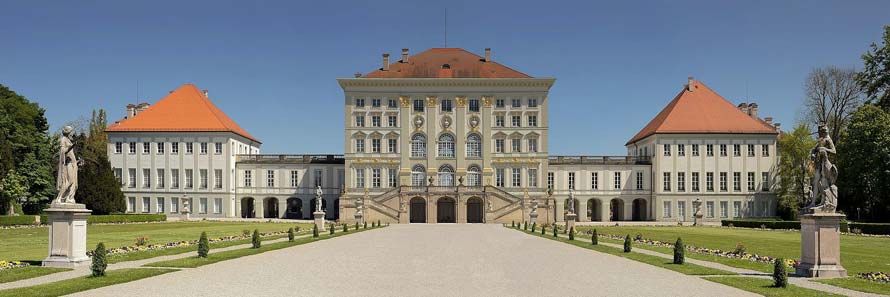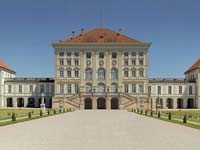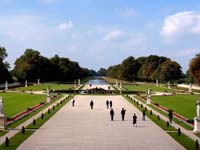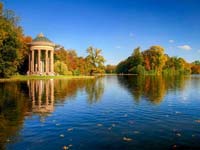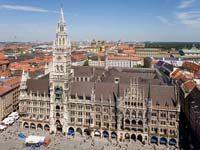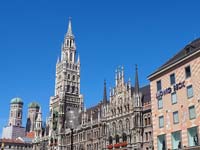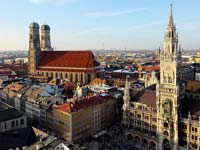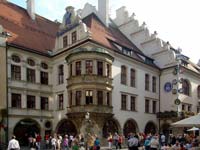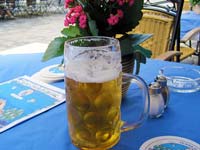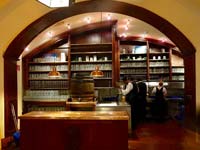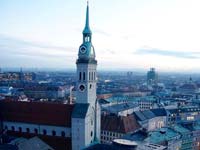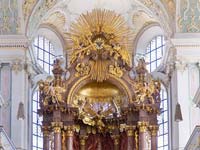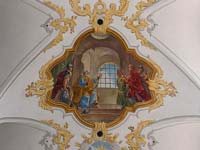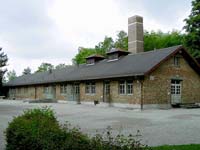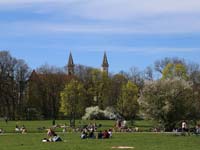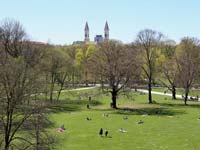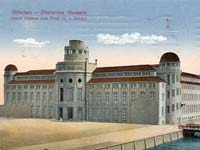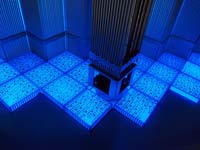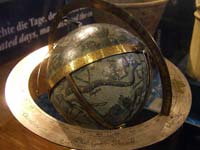Things to do in Munich, GERMANY
As the host of the world’s largest beer festival, Munich is a city where history and fun come together in perfect balance.
Without a doubt, Munich is one of Germany’s most popular cities. It is beautiful, well-preserved, full of museums, and culturally refined. It is also one of the best places in the country to enjoy nightlife and beer. Visitors spend the day exploring the historic centre, drinking beer, going into charming little streets and boutique shops, touring former royal palaces, and spending the day at a museum.
Whether you’re visiting museums, watching the clock tower, or drinking beer, you will see how proud locals are of their costumes. Old men in lederhosen -the traditional dress of the region- still wander the streets, and you’ll find it difficult to find someone whose eyes don’t shine with pride as they talk about their beautiful city.
To make the most out of your time in Munich, here are the top things to do:
1. Nymphenburg Palace
The former royal palace has kept its elegance throughout the ages, and provides visitors with the opportunity for delightful walks.
Once the summer residence of the Wittelsbachs, the former rulers of Bavaria, the Nymphenburg Palace is one of Munich’s most well-recognized landmarks.
Its opulence and grandeur attract hundreds of thousands of visitors each year, who enjoy imagining the life of European royals.
The palace offers guided and free tours of the royal quarters, giving an insight into the personal lives of the Wittelsbachs, and has numerous exhibits like the Carriage Museum, the Porcelain Museum, and the Gallery of Beauties.
One of its most popular activities, however, are the extensive gardens, where visitors can roam freely (see the pictured grand parterre and lake). With English gardens, statues, and woods, it is easy to spend an entire day exploring Nymphenburg.
where? Located on the West of the city, the palace is easily accessible on public transit. You can take the suburban railway (S-Bahn) to the Laim stop and transfer to a bus line heading to Schloss Nymphenburg. Alternatively you can take a tram to a stop by the same name.
when? The main gates of the palace open from 6 am to 6 pm from December to March. During April and October, they open from 6:00 am to 8:00 pm, and from May to September from 6:00 am to 9:30 pm Please note that each exhibition and pavilion operates on individual hours, so check the times for your particular interests.
£$€¥ While visiting the Nymphenburg, you can choose which part of the palace you want to pay to visit. To see just the palace, the entrance is $7. For the museums of Carriages and Porcelain it is $5, and for the parks it is $5. Visitors can buy a combination ticket that allows them entry into all of the above. This ticket costs $12 from April to October, and $9 from October to March. If visiting during the summer, you can pay $15 for a gondola ride on the lake.
2. Marienplatz
Dating back to the 12th century, this beautiful square is the heart and soul of Munich.
Marienplatz has existed almost as long as independent Munich has. This central plaza has seen the transformation of the city throughout the ages, withstanding the test of time.
It has been the site of festivals, witch burns, and tournaments, and has seen the daily life of locals change over the centuries. Today, it is one of the main landmarks in Munich, and a major centre of commerce with various shops and restaurants.
Besides being a perfect place to sit down for a cup of coffee and people watch, Marienplatz is surrounded by some of the most important buildings in the city.
You’ll find the Old and New Town Halls in their architectural glory, the Council Hall, and the Mariensaule, the iconic column of the Virgin Mary. The astronomical clock in its New Town Hall is a major attraction, with hundreds of people gathering at certain hours to see its figurines dance.
where? While in Munich, it will be difficult to miss Marienplatz, as it is truly the city centre. To get there, you can take the S-Bahn or the U-Bahn to the Marienplatz station.
when? Late morning to early evening is probably the best time to visit the square, as it is when all restaurants and shops are open. 11 am, 12 pm, and 5 pm are prime times, since they mark the hours when the clock tower display occurs.
£$€¥ It is possible to visit Marienplatz without spending any money, as appreciating the architecture and people watching are some of the preferred activities. However, if you plan on shopping or dining, be prepared to spend a higher price than in other places in the city.
3. Hofbrauhaus
No visit to Munich is complete without a stop at the most famous beer garden in the world.
If there is ever a city to enjoy a good pint of beer, it’s Munich. And there’s no better place to do it (outside of Oktoberfest) than in Hofbrauhaus. Known all over the world for its high vibes, quality beer, and a history dating back to the 16th century, the beer garden is an intrinsic part of Munich’s identity.
First commissioned by the Duke of Bavaria, it is one of the few state-owned beer halls in the world, and is definitely one of the centers of Munich’s nightlife scene. Young and old, bohemian and rich, you can find it all in the three floors and outdoors spaces of the brewery.
Hofbrauhaus franchises have popped up all over America, including in Las Vegas.
where? Hofbrauhaus is located at Platzl 9 in the city centre. There is no station directly in front of the beer hall, but the three closest public transit stations are Tal, Kammerspiele, and Marienplatz.
when? Many people are surprised to learn that the beer hall opens daily at 9 am and closes at 11 pm. However, as one of the staples of German culture, it’s not unusual for people to come here during the late morning to enjoy beers before lunch. It is also one of the first stops of bar crawls.
£$€¥ Perhaps the best thing about Hofbrauhaus is how cheap it is for the quality of the beer. You’ll enjoy pints and a sturdy meal for less than $20.
4. St Peter's Church
As the most important church in Munich, it also offers the most astonishing view of the city.
Thought to be the originating point of Munich, St. Peter’s significance cannot be overstated. Its history goes back to 1150, making it the oldest church (and standing building) in the city.
Over the years, fires, restorations, and cultural changes have added different styles to its architecture. The church manages to meld Romanesque, Gothic, Renaissance, and Baroque in a beautiful harmony that plays on the uniqueness of each style.
The St. Martin Altar is the opulent centerpiece of the church, and perhaps its most beautiful architecture.
Besides its historic importance and aesthetic appeal, St. Peter’s is also known for having the best 360 degree view of Munich from its tower.
where? The church is located next to Marienplatz on the city centre. The most convenient way to access it on public transportation is from the Marienplatz station.
when? St. Peter’s operates at regular hours for a place of worship. The tower is open Monday through Friday from 9:00 am to 6:00 pm, and Saturday and Sunday from 10:00 am to 6:00 pm.
£$€¥ Entrance to the church is free, though visitors are encouraged to give a donation. Entrance to the tower is around $3.
5. Dachau Concentration Camp
As one of the most infamous concentration camps in Germany, Dachau is a symbol of a past that is hard to think about but necessary to remember.
First opened in 1933 by Heinrich Himmler, Dachau was the first concentration camp opened in Germany. Intended for political prisoners in Hitler’s initial years in power, it eventually became a work camp that imprisoned and exterminated hundreds of thousands of prisoners which included Jews, homosexuals, Gypsies, and many other groups.
The camp was liberated by allied forces in 1945, when the atrocities of the Holocaust were revealed to the world.
Today, the camp remains mainly intact and is a Holocaust museum and memorial, acting as a sobering reminder of a past that should never be repeated. Visitors come here to ponder over a darker yet important side of Germany.
where? Dachau is a suburb of Munich and can be reached within less than 20 minutes. You can take the S2 train or the high speed RB train, which takes you in about half the time. From the train station, get on the #726 bus line to Saubachsiedlung, which will leave you in front of the camp.
when? The concentration camp is open daily from 9:00 am to 5:00 pm. Two to three hours are recommended to see all the sites and memorials.
£$€¥ In the spirit of educating people about the horrors of the Holocaust, entrance to Dachau is free. An audio guide is offered for $4.
6. The English Garden
Arguably one of the most interesting public parks in the world, the English Garden is Munich’s verdant paradise.
Built at the end of the 18th century, the Englischer Garten is an oasis of green in the city. Its 910 acres place it amongst the largest public parks in the continent, and its characteristics definitely make it one of the most varied and entertaining.
Like most other European gardens, it has vast grass-covered spaces where people enjoy playing sports, having family outings, picnicking, and taking naps. It also offers a boating lake where people can row during warmer months, and jogging and biking paths that are pleasant and safe.
What sets it apart, however, are its various and contrasting monuments. With a gorgeous Japanese teahouse, a temple to Apollo standing on top of a manmade hill, an imposing Chinese Tower, an open air amphitheatre, and two beer gardens, there are as many things to see as there are things to do.
Parts of it also serve as pasture for sheep during certain times of the year. Oh, and for free spirits, there is Schonfeld Meadow, where nude sunbathing is permitted.
where? The English Garden is located at the city centre, and stretches all the way to the north of the city. Because of its large size, there are several buses, trams, and subway stations around it. If having too many choices is stressful for you, just take Tram 18 and get off at one of the stations surrounding the park.
when? As with most public gardens, the park is best visited at anytime between early morning and early evening. Activities like boating and sunbathing are, of course, only possible when the weather is warm. However, winter still receives many visitors, as its many landmarks and paths are beautiful during the season.
£$€¥ Being a public park, there is no entrance fee. However, some activities like going to the beer gardens and renting a boat or a bike will cost money.
7. Deutsches Museum
The largest science and technology museum in the entire world, it is a prefered activity for visitors of all ages.
Expanding six floors that showcase around 28,000 items, the Deutsches Museum is the largest in Munich, and one of its most impressive landmarks. Construction began in 1903 on an island on the Isar River, later named Museum Island.
The museum suffered considerable losses during World War II, where as much as 80% of the building was damaged and destroyed. Luckily, only 20% of the exhibited items were damaged or lost, allowing the museum to get back on its feet after the war ended.
Almost from its inception, the Deutsches Museum has been a source of pride for the city. It comprises fields as varied and interesting as aerospace, metallurgy, music, printing, agriculture, and energy technology.
Its exhibitions are interactive and engaging, making it a perfect experience for museum nerds flying solo, as well as families and groups.
where? The Deutsches Museum is located on Museumsinsel, or Museum Island. To arrive, take the S-Bahn to Isartor station, or the U-Bahn to Fraunhoferstraße.
when? The museum is open every day from 9:00 am to 5:00 pm. Unlike other museums and landmarks, its opening hours do not change with the season of the year. As it is a popular activity, it is advisable that you arrive as early as possible to avoid long lines.
£$€¥ Price of admission is €11 for adults, and €4 for students with a proper form of ID. Of course, visitors who wish to buy souvenirs at the gift shop should expect to find relatively high prices.
